| << Chapter < Page | Chapter >> Page > |
Velocity – time plot
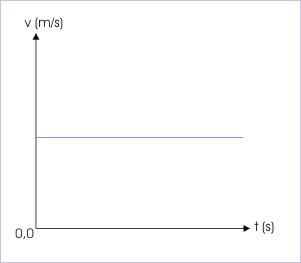
2: Acceleration is constant
Constant acceleration means that instantaneous acceleration at all points during motion is same. It, therefore, implies that instantaneous acceleration at any time instant and average acceleration in any time interval during motion are equal.
Velocity of the object under motion changes by an equal value in equal time interval. It implies that the velocity – time plot for constant acceleration should be a straight line. Here,
Integrating both sides,
This is a linear equation in time “t” representing a straight line, where “a” is acceleration and is equal to the slope of the straight line and "u" is the intercept on velocity axis, representing velocity at t = 0. The plot of velocity with respect to time, therefore, is a straight line as shown in the figure here.
Velocity – time plot
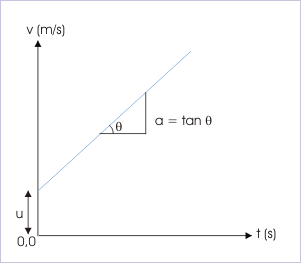
For constant deceleration, the velocity – time plot has negative slope. Here, speed decreases with the passage of time :
Velocity – time plot
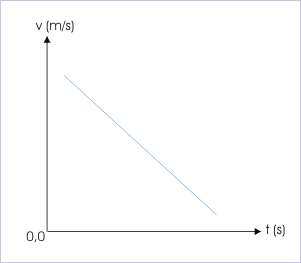
Problem : A velocity – time plot describing motion of a particle in one dimension is shown in the figure.
Velocity – time plot
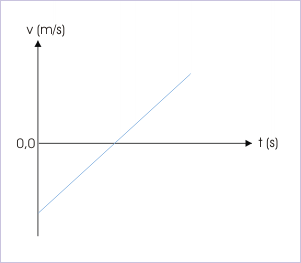
Determine (i) Whether the direction of velocity is reversed during motion? (ii) Does the particle stop? (iii) Does the motion involve deceleration and (iv) Is the acceleration constant?
Solution : (i) We see that velocity in the beginning is negative and changes to positive after some time. Hence, there is reversal of the direction of motion.
(ii) Yes. Velocity of the particle becomes zero at a particular time, when plot crosses time axis. This observation indicates an interesting aspect of reversal of direction of motion (i.e. velocity): A reversal of direction of a motion requires that the particle is stopped before the direction is reversed.
(iii) Yes. Occurance of decelration is determined by comparing directions of velocity and acceleration. In the period before the particle comes to rest, velocity is negative, wheras acceleration is always positive with respect to the positive direction of velocity (slope of the line is positive on velocity -time plot). Thus, velocity and acceleration are in opposite direction for this part of motion and is decelerated. Further, it is also seen that speed of the particle is decreasing in this period.
(iv) The plot is straight line with a constant slope. Thus, motion is under constant acceleration.
3: The magnitude of acceleration is increasing
Since slope of velocity – time curve is equal to the acceleration at that instant, it is expected that velocity – time plot should be a curve, whose slope increases with time as shown in the figure.
Velocity – time plot
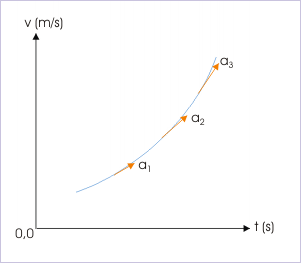
Here,
4: The magnitude of acceleration is decreasing
The velocity – time plot should be a curve, whose slope decreases with time as shown in the figure here :
Velocity – time plot
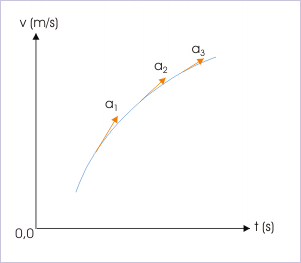
Here,
Problem : A person walks with a velocity given by |t – 2| along a straight line. Find the distance and displacement for the motion in the first 4 seconds. What are the average velocity and acceleration in this period? Discuss the nature of acceleration.
Solution : Here, velocity is equal to the modulus of a function in time. It means that velocity is always positive. The representative values at the end of every second in the interval of 4 seconds are tabulated as below :
----------------------------
Time (s) Velocity (m/s)----------------------------
0 21 1
2 03 1
4 2----------------------------
An inspection of the values in the table reveals that velocity linearly decreases for the first 2 second from 2 m/s to zero. It, then, increases from zero to 2 m/s. In order to obtain distance and displacement, we draw the plot between displacement and time as shown.
Velocity – time plot
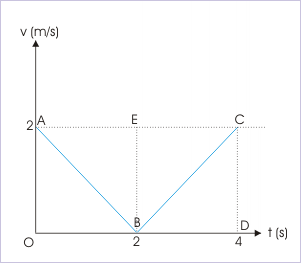
Now, area under the plot gives displacement.
We see that velocity does not change its sign. Thus, motion is unidirectional apart from being rectilinear. As such, distance is equal to displacement and is also 4 m.
Now, average velocity is given by :
Similarly, average acceleration during the motion is :
Though average acceleration is zero, the instantaneous acceleration of the motion during whole period is not constant as the velocity – time plot is not a single straight line. An inspection of the plot reveals that velocity – time has two line segments AB and BC, each of which separately represents constant acceleration.
Magnitude of constant acceleration (instantaneous) in the first part of the motion is equal to the slope of the displacement – time plot AB :
Similarly, acceleration in the second part of the motion is :
Thus, the acceleration of the motion is negative for the first part of motion and positive for the second of motion with respect to velocity on velocity-time plot. We can, therefore, conclude that acceleration is not constant.

Notification Switch
Would you like to follow the 'Physics for k-12' conversation and receive update notifications?